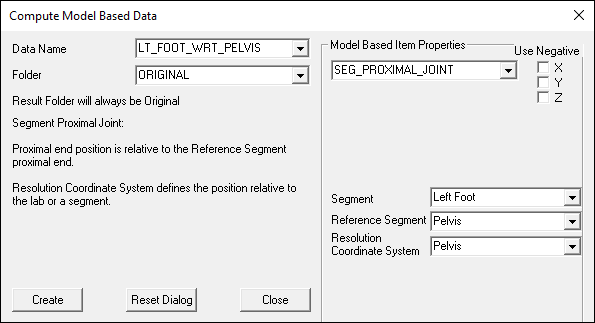Seg Proximal Joint
The Segment Proximal End Position can be resolved into any segment coordinate system.
For example, to compute the location of the proximal end of the foot relative to the pelvis, set the segment to be the foot and the reference coordinate system to be the pelvis.
Example - Computing the Relative Movement at a 6 DOF "joint"
Visual3D recognizes “joints” in a 6 DOF model when the proximal/distal ends of two segments are sufficiently close. This joint is a bookkeeping device and not a constraint on the segments' poses, which are estimated independently. This means that there can be translations between the segment ends accounted for by the 6 DOF joint, and these translations can be calculated as follows.
The relative movement of the knee joint in a 6 DOF model can be computed as the difference in locations of the proximal end of the shank relative and the distal end of the thigh resolved into the thigh's coordinate system. This is most straightforward by using the “Seg_Proximal_Joint” model-based item:
- “Segment”= shank
- “Reference Segment”= thigh
- “Resolution Coordinate System”= thigh
This item definition will produce the desired answer as long as the origin of the thigh's segment coordinate system is at the distal end of the thigh (e.g. adjacent to the proximal end of the shank). If it is not, then the trick is to create a new thigh segment that satisfies this requirement.
A straightforward way to accomplish this is to build a second thigh segment:
- make it a kinematic only segment because you wouldn't want two thigh segments included in the inverse dynamics calculations
- use the proximal end markers of the original thigh segment as the distal end markers of the new thigh segment
- similarly, use the distal end markers of the original thigh segment as the proximal end markers of the new thigh segment.
At this point you will note that the segment coordinate systems for the two thigh segments are not aligned. In the Segment Properties tab you can specify the Segment Orientation. If the original thigh segment had A/P Axis=+Y; Distal to Proximal=+Z, the new thigh segment should have A/P Axis=-Y; Distal to Proximal=-Z. The Seg_Proximal_Joint model-based item can now be computed using the new thigh segment.

